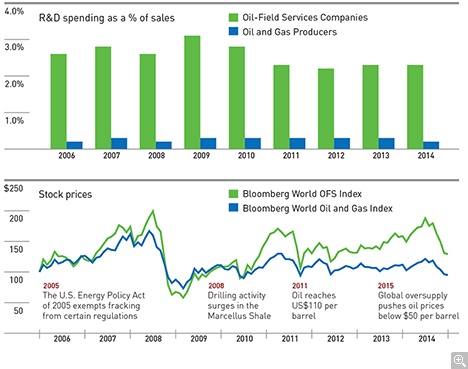How R&D Can Transform the Oil & Gas Industry
From operating our vehicles to warming our homes, oil and gas is one the most commonly used and important commodities in the world. In 2014, oil provided approximately 38% of the world’s energy needs and is directly responsible for about 2.5% of world GDP. Indeed, oil and gas is a leading component of the world’s energy mix, a trend that will no doubt endure for many years to come.
However, in an increasingly technologically-driven world, the oil and gas industry is changing in two fundamental ways. Firstly, with majority of the world’s ‘easy oil’ already exhausted, the importance of utilizing sophisticated technologies to find and produce tomorrow’s hydrocarbons is becoming increasingly imperative. Secondly, high profile disasters such as Shell’s Brent Spar Incident in 1995 or the recent Deepwater Horizon accident (Perrons, 2014), has resulted in a significant shift in the expectations of the oil and gas industry in regards to safety, environmental stewardship and human welfare. Thus, in the face of these challenges, technology and innovation will play a pivotal role in the success or failure of the future of oil and gas firms.
Generating the question, how can oil and gas companies succeed in an industry where supply is limited and expectations are high? One way is through investing in research and development (R&D) to drive innovation and create new and improved technologies. Certainly, one would expect that the economic rewards in an industry that is perceptibly more technology-driven would go to the firms that create most of the innovations – and, indeed, that seems to be happening. Several international oil companies (IOCs) and national oil companies (NOCs) have increased their spending on R&D dramatically over the past years. In particular, oil-field service companies have greatly increased their investment in innovation which has correlated with higher stock prices, as seen below.
Without a doubt, investing in R&D to create new and improved technologies is vital in enabling the industry to meet global energy demand. Moreover, with traditional forms of energy becoming harder to find, investing in new technologies will be critical in meeting the needs of an increasingly urbanised population and to combat environmental challenges in the decades ahead.
In addition, several companies may already be partaking in R&D activities and may not be aware of how the federal and state governments seek to support them by encouraging innovation through  the Research and Development Tax Credit. Oil and gas companies are eligible for this incentive, which presently values at almost 10 billion dollars, for work activities that are often already being conducted. Many of these activities may not occur in traditional laboratories or are not usually thought of as ‘research’. Nonetheless, these undertakings entail time and money that may be defined as qualified research expenditures resulting in substantial tax benefits. Both large and small companies in the oil and gas industry are able to get the incentive – contact Swanson Reed’s R&D tax specialists today to see if you’re eligible.
the Research and Development Tax Credit. Oil and gas companies are eligible for this incentive, which presently values at almost 10 billion dollars, for work activities that are often already being conducted. Many of these activities may not occur in traditional laboratories or are not usually thought of as ‘research’. Nonetheless, these undertakings entail time and money that may be defined as qualified research expenditures resulting in substantial tax benefits. Both large and small companies in the oil and gas industry are able to get the incentive – contact Swanson Reed’s R&D tax specialists today to see if you’re eligible.

















